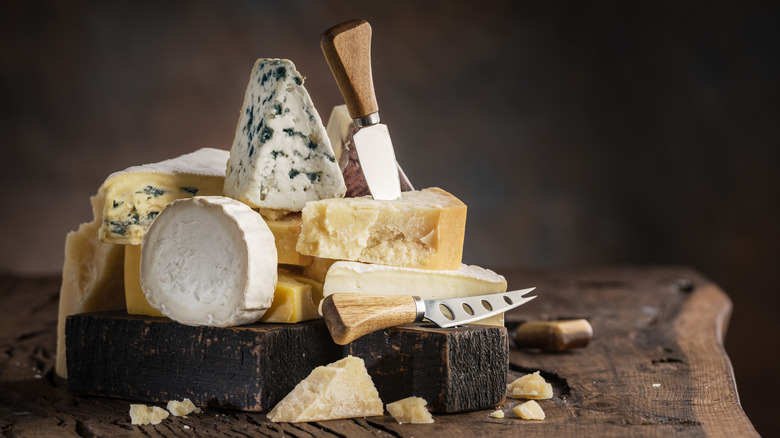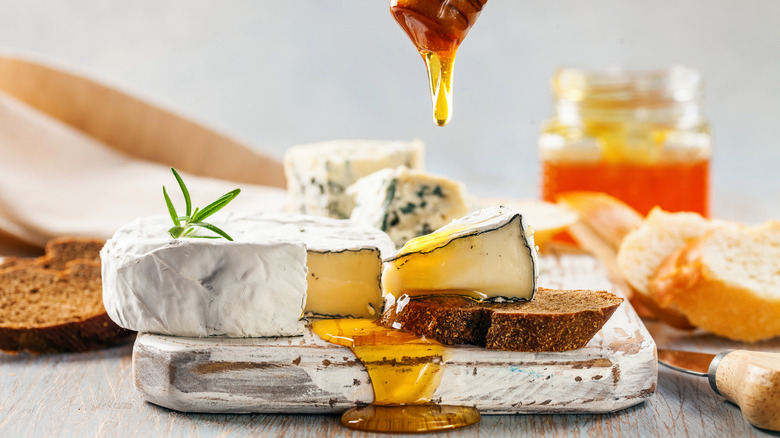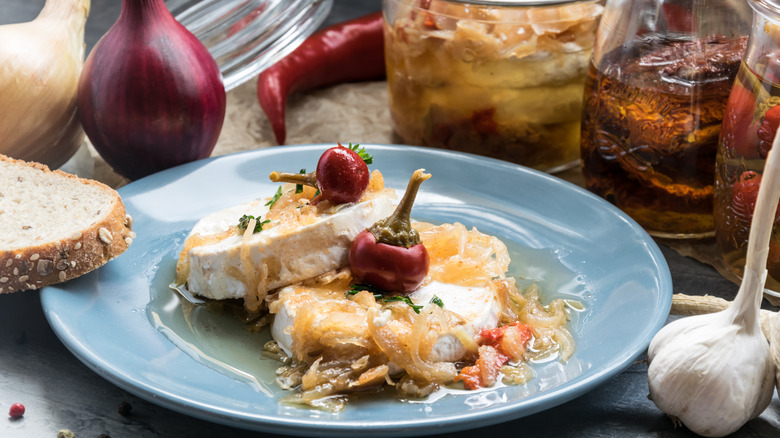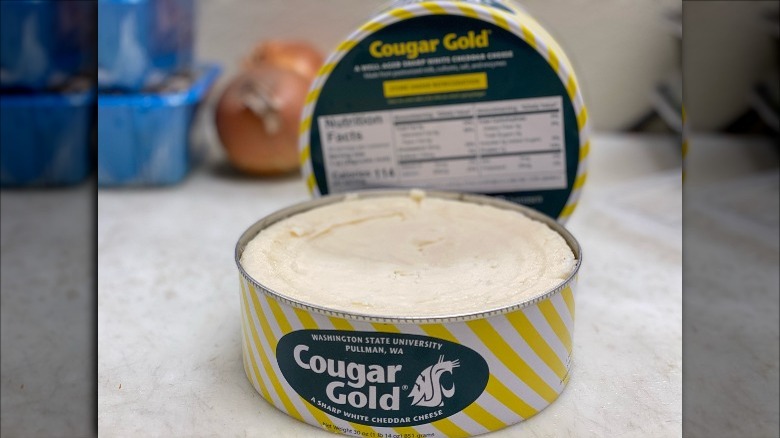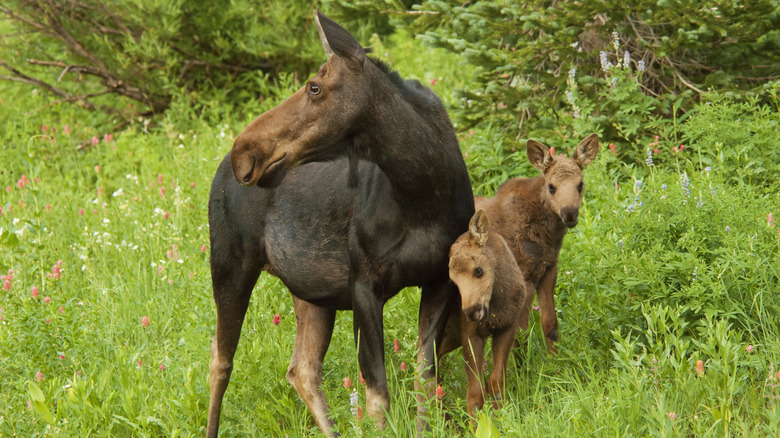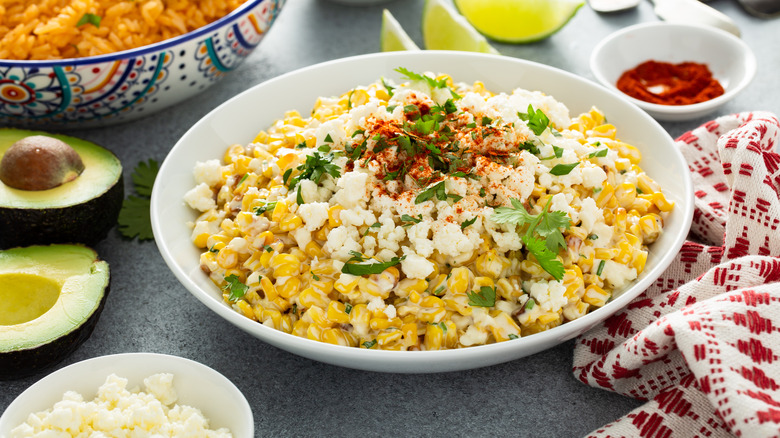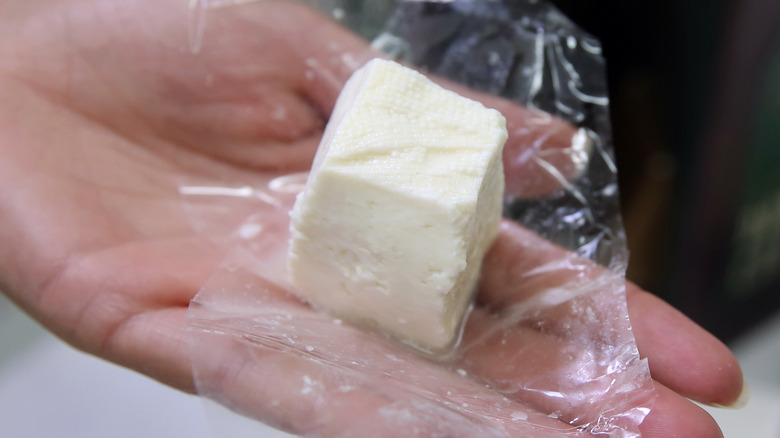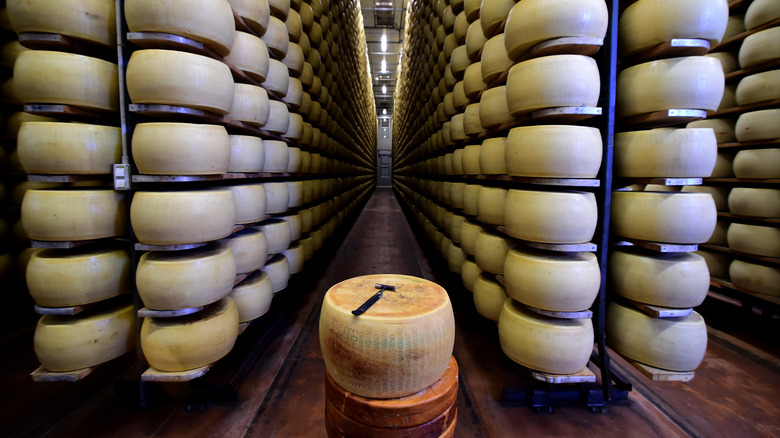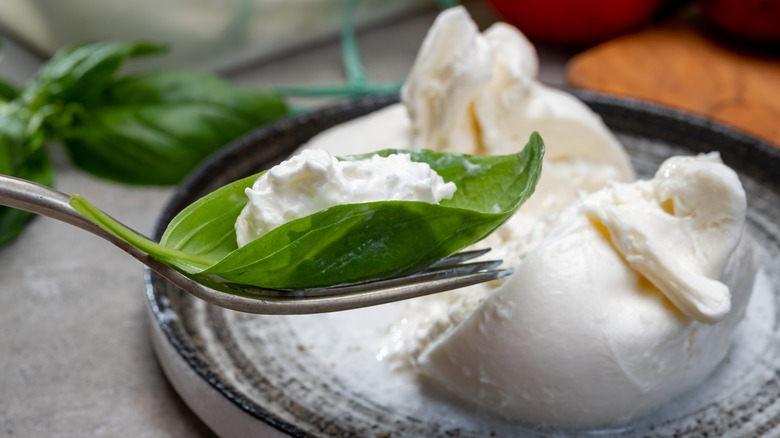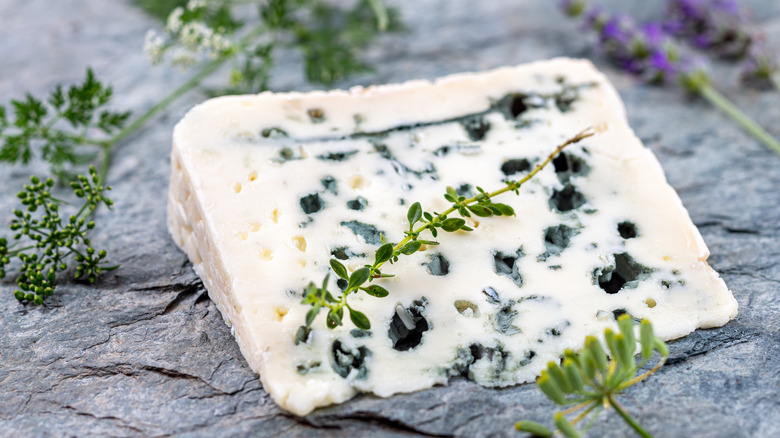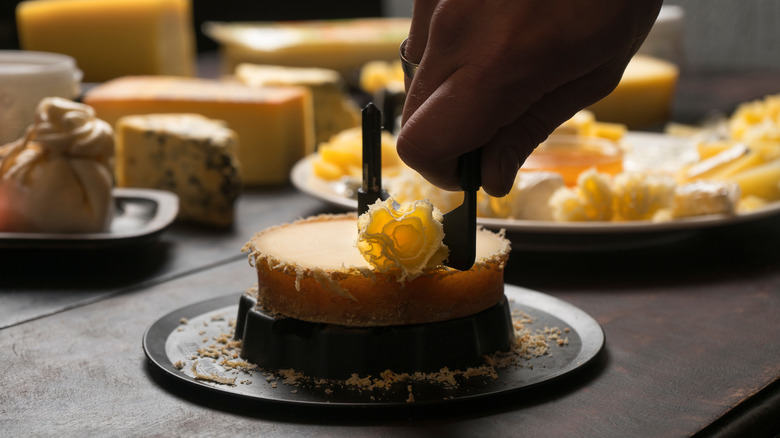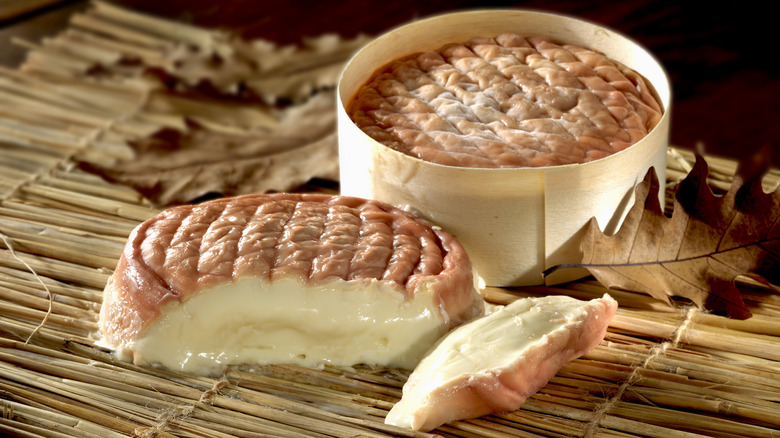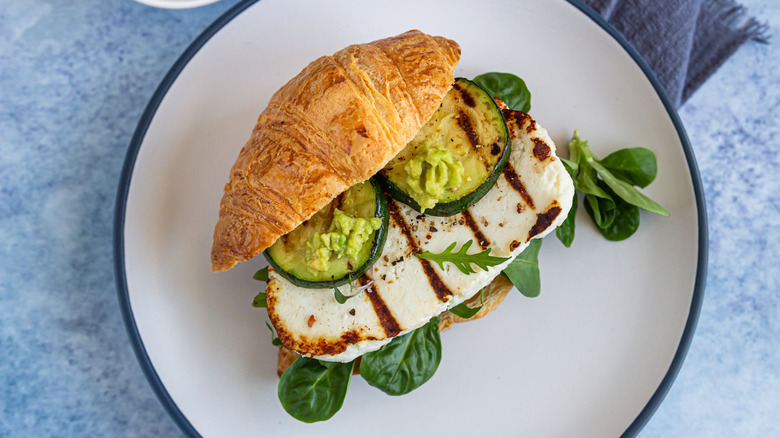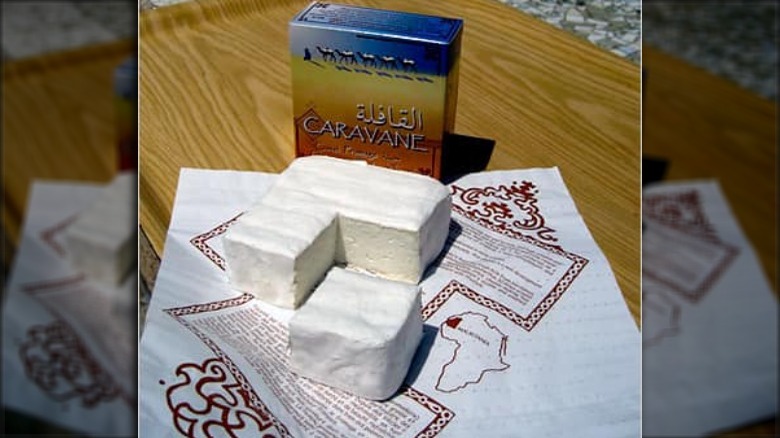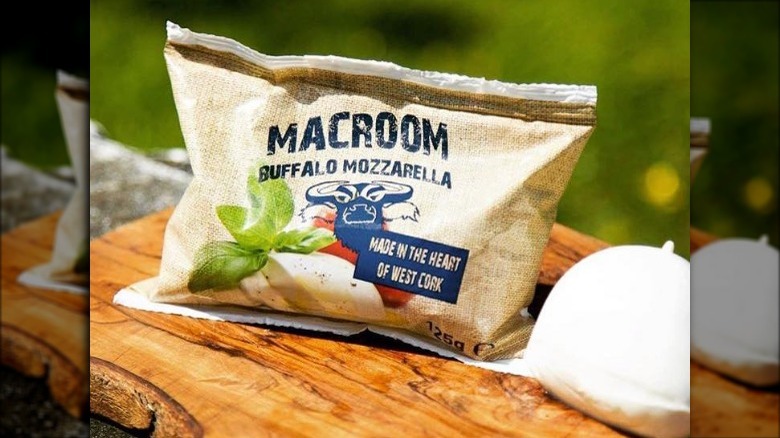Unique Cheese You Need To Try At Least Once In Your Lifetime
Mankind has masterminded a wide variety of amazing inventions, from cars and computers to light bulbs, indoor plumbing, and ergonomic chairs. All told, a lot of really cool stuff has been created because of the human mind's tendency to want to know what would happen if we put this thing here, that thing there, and pushed the button. When it comes to great culinary creations, cheese has got to be at the top of the list. Sure, it's a little weird, but without it, there would be no pizza or lasagna — and that would make the world a very sad place, indeed. Who would want to live in a universe without cheese?
Head to the grocery store, and there's bound to be the old favorites on the shelves. That's things like cheddar, mozzarella, Swiss, and more, served in shreds, bricks, and slices, for starters. But if you love cheese — and we mean really, really love cheese — you definitely shouldn't stop there. The number of cheeses out in the wild seem infinite, and even if you try some of these unique types of cheese just once, they're all completely worthy of being on your bucket list.
Brie Noir: France
Brie is a pretty popular type of cheese, but what the heck is Brie Noir? According to Bustle, Brie Noir is made and found almost solely in France's Seine et Marne region. If that sounds a bit too far to travel, then good news! If you're going to Paris, it's only a stone's throw away, and you'll be able to find Brie Noir at most Parisian cheese shops.
So, what is it? It's essentially regular Brie, but instead of aging it only five to 10 weeks, the cheese sits for months before it's ready to be eaten. The result is a brie that's surprisingly hard and crumbly, with a taste described by the French Cheese Board as a bit of toffee, a bit of caramel, and a touch of "farm animal ammonia" (via Bustle).
The practice of ultra-aging Brie into Brie Noir goes back to a time when less-than-perfect cheese rounds would be shoved into a cellar, aged, and then sold to the lower classes at a cheap price instead of being wasted. That sort of no-waste philosophy is respectable no matter what century it is.
Nakladany Hermelin: Czech Republic
Nakladany Hermelin is sort of a version of Camembert. According to The Washington Post, Czech cheesemakers were trying to come up with their own native version of the popular French cheese when they created Nakladany Hermelin, but that's not the whole story.
This isn't Camembert as you know it, because this now-popular pub staple is typically marinated first. Atlas Obscura says that the cheese is halved then left to sit in a mix of oil, pepper, garlic, and bay leaves for at least 10 days (and up to 2 weeks). The longer it's left, the better it is, aficionados say, as it tends to pick up the flavors of whatever it's been marinating in. The cheese becomes soft and almost runny, and it's pretty much the perfect thing to have alongside a frosty pint. If you're not heading to Eastern Europe anytime soon, you can make a passable version of it in your own kitchen by marinating a wheel of Camembert.
Cougar Gold: United States
When you think about it a certain way, meat has Spam, and cheese has Cougar Gold. Cougar Gold is named for creator, Norman Shirley Golding, who was a food science professor at Washington State University back in the 1940s. That, says The Daily Evergreen, is when he got a request from the US government to invent cheese that could be kept in tins and be easily shipped to the Allied troops fighting overseas in World War II.
The WSU Creamery still makes the cheese in the same way, thanks to students who spend as long as eight hours making a single batch. It's then aged for a year before it hits shelves, and yes, you can absolutely buy it right from the creamery. It's got a sharp, nutty flavor, and don't be surprised when you crack the old-timey tin to find that it's white and not yellow-gold, as you might expect. While it's a little too pricey to buy in bulk for stocking your apocalypse bunker, this tinned cheese with wartime roots is definitely worth the price at least once in your life.
Neufchatel: France
Valentine's Day and anniversaries can be tough, even if you're happily paired up. There are only so many times you can gift the same box of chocolates, so how about mixing it up and opting for some heart-shaped cheese?
Neufchatel is a soft cheese from the Haute Normandy region in France, and even though they've been making it since the 10th century, the practice of making the cheeses heart-shaped is a little more modern ... but not by much. That, The Courtyard Dairy says, goes back to the Hundred Years' War, fought between 1337 and 1453. The area was occupied by the English. As the story goes, French women who were interested in the occupiers would often give Neufchatel — in the shape of a heart — to the object of their affections.
That gives it some legit credit as a romantic gift, and let's be honest: Who wouldn't prefer cheese over flowers that are going to die in a week? That's what we thought. As for the cheese itself, it's a soft, velvety white cheese that Regions of France says is much creamier than most cheeses, thanks to the lush pastures cows in Normandy have the good fortune to graze on.
Moose cheese: Sweden
In theory, you can make cheese out of any kind of animal's milk, and while we're not going to go too far down that rabbit hole, we are going to go just far enough to get to the majestic moose.
According to Twisted, there's one place in the world that's making cheese from moose milk, and that's The Elk House in Bjurholm, Sweden. Visitors not only get to try cocktails made with moose milk, but cheese, too — and all that creamy goodness (and a daily dose of wholesome) comes from three moose sisters named Juno, Gullan, and Haelga.
The very patient people at the Elk House actually make a few different kinds of cheeses with their moose milk, including feta, an almost-Camembert, and blue cheese. You'll have to head there in order to try some, though, but consider the bonus treat that you'll get to see a moose or three!
Paneer: India
While we know that your typical cheese isn't vegan, the Vegetarian Society says that most of it's not vegetarian, either. That's because animal rennet is a common ingredient in cheese. It's an enzyme extracted from the stomach lining of calves. Sorry if that ruins cheese for anyone.
If it did, that's just another reason to try paneer. This Indian cheese isn't made with rennet at all, and cheesemakers rely on other acidic ingredients — like yogurt or lemon juice — to curdle the milk and start the cheese-making process. And it's a huge deal, as, according to Marigold Maison, paneer is an important alternative for those who follow Hinduism and consider cows sacred (and definitely not edible).
Paneer, typically made from a blend of cow's and buffalo's milk, is surprisingly versatile. It holds up to heat well, can be deep-fried, and has a texture that's somewhere between feta and firm tofu. Eat it by the cube or crumble it over a salad (or hot dish), and it doesn't take much to see why this cheese has been incredibly popular since its modern form was developed in the 16th century.
Cotija: Mexico
Cotija cheese shares a name with the town where it was originally made, and those who love it take it very seriously. If you still stick with cheddar for taco night, give this a try and it'll absolutely be a game-changer.
Specialty Cheeses says that this particular cheese is brilliant on hot dishes — like those tacos — because it doesn't melt and holds whatever shape you grate or crumble it into. It's also very salty, which basically means you're not just adding cheese, you're adding a flavor enhancer, too. Just like Parmesan can add a kick of flavor to whatever it's sprinkled on, Cotija can do the same. Really, anything you use Parmesan on, you can use Cotija. And you should, as Healthline says that adding aged cheeses to a dish to boost umami flavor is a healthy option for those looking to make small changes that will add up to a big deal.
Pule: Serbia
When it comes to talking about cheeses that you're only going to want to try once, pule cheese is definitely part of the conversation. That's not because of the flavor, either, but because of its price tag. A single kilogram will set you back somewhere around $600, but Business Insider found there's a good reason for that rather shocking price.
Pule cheese is made with a top-secret recipe known by just one person: Slobodan Simic. He's also the person in charge of overseeing the endangered Balkan donkeys that produce the milk for pule cheese, and runs the farm on the Zasavica Special Nature Reserve — which, incidentally, is also the only place you'll be able to try it.
Pule is made from a 60-40 ratio of donkey and goat milk. Furthermore, each donkey is only milked for six months after her baby is weaned. Donkeys, it turns out, don't give as much milk as cows do — not by a long shot — but the product is worth it for a few reasons. The cheese is reportedly soft and very rich, and even better? It's all being done to support the resurgence of an endangered breed.
Parmigiana Reggiano: Italy
Wait, why on earth would we be telling you to try Parmigiana Reggiano at least once? There's a good chance you have some in your fridge, right? Well, it turns out that you probably don't.
When travel journalist Larry Olmsted spoke to Forbes about the phenomenon of fake cheese, he said that the vast majority of so-called Parmesan cheese bought in the US has a whole laundry list of ingredients. Those are actually illegal when it comes time to designate the real thing. Real Parmigiana Reggiano can only have salt, rennet, and milk in it, and there are some strict laws governing that, too. That milk, for example, needs to get from the cow into the cheese in less than 20 hours, or it's just not going to cut it. Now, go check your fridge. (We'll wait.) Whether you have Kraft in a can or some fancy-schmancy Parm from a high-end grocer, it's still probably not the real thing.
Does it matter? Yes, says Olmsted. Real Parmigiana Reggiano adds a major umami kick to a meal and it only takes a dash of the genuine stuff to get some truly impressive results. Look for the real thing, and you'll never go back to plain old Parmesan ever again.
Burrata: Italy
Real talk here: The best part of making homemade pizza is getting to eat all the leftover mozzarella, isn't it? If you love mozzarella and agree with that, then you'll absolutely love burrata. There's a reason it's called the Queen of Italian Cheeses, and it's a title that's definitely been earned over the years. Imagine the best, freshest mozzarella you can find, and then imagine a lighter, creamier, softer, even fresher version of that — and that's just the start of imagining burrata.
According to Fine Dining Lovers, burrata is essentially a cheese-within-a-cheese. On the outside, there's a shell of fresh mozzarella. Tear through that, and inside is a cheesy center made from fresh curd and cream — basically, what's called "un-pulled" mozzarella. It's typically served with just a bit of salad or bread. That's it, as this cheese definitely doesn't need decorations.
There is a catch, though, as experts recommend that you eat it no more than 24 hours after it's been made. This means that you'll have to head to Italy for the real experience. Twist your arm, right?
Roquefort: France
Everyone knows that it's really blue cheese dressing you put on Buffalo wings, right? Right. Now that we've got that out of the way, let's talk about the blue cheese that every wing-lover or cheese connoisseur needs to try. That's real Roquefort.
Roquefort, says France Today, comes from the tiny, 600-citizen town of Roquefort-sur-Soulzon, and specifically, from the cellars beneath that town. Seven different companies share the cellars — which are allow for the growth of a particular mold — and while each has its own top-secret recipe, they do have something else besides the caves in common. They're all using milk from Lacaunes sheep, which graze on the lush fields and pass along a richness to the milk and, in turn, the cheese. It's a unique combination of rich grass, richer milk, and mold that creates something of a perfect storm that leads to a brilliant end result: A cheese you need to try to believe.
Visit France, and you'll find numerous varieties of Roquefort. They're all amazing, and it's impossible to go wrong ... chicken wings not required.
Tete de Moine: Switzerland
Tete de Moine means "monk's head," and at first, it looks like a pretty standard cheese. Don't just take a hunk out of it and dig in, though. Instead, you'll need to shave it.
Alpenwild says shaving this particular cheese changes it into something that melts in your mouth, and it's consumed with a special tool called a girolle that makes paper-thin portions of cheese. Cheeses from Switzerland says that the cheese was so prized that as far back as the 12th century, it was even used as currency. It's still made in the same region of Switzerland that it's been made in for hundreds of years, with just 10 creameries milking cows that have grazed on lush Swiss slopes. Makers age this cheese for at least two and a half months before it's turned into delicate rosettes just before being enjoyed. Magical? Pretty darn close.
Epoisses: France
Culture says the origins of this French cheese are a little unclear, but it's been around more than 400 years. Originally made by Cistercian monks from the town that shares a name with the cheese, the process for making it was nearly lost during World War II. Fortunately, it wasn't, and it's now regularly made in Burgundy.
What makes this a must-try? A few things, starting with the fact that it's not just made from milk (which, according to law, must come from Brown Swiss cows), but also from brandy. The brandy is what helps develop good bacteria that makes the rind and the distinctive color. That rind is important. Really, really important. When you cut into Epoisses, the cheese inside has a texture that's likened to custard or pudding. That — along with a unique, earthy flavor — makes it an entire experience, but since it's made from unpasteurized milk, you'll have to head to France to try it.
Halloumi: Cyprus
There's a good chance you might have seen halloumi on the shelves at your favorite grocery store, and if you tend to give it a miss, it's time to stop. Halloumi is nothing short of amazing. It's so popular in Britain that, in 2019, The Guardian reported that a potential halloumi shortage sent the country into a tizzy.
So, what's the big deal? Manoosh says halloumi has been around since some time in the Medieval Byzantine era (which started in the year 395), and it's traditionally been a major source of protein. It's made from a combination of goat and sheep's milk and has an incredibly high melting point. That means you can throw it on the grill, and if there's anything your life may have been missing, it's very literal grilled cheese — no bread required. It's a little salty before it's cooked, but heat it up and it transforms into a savory, creamy, delicious cheese.
Caravane: Mauritania
Some cheeses have a history of hundreds of years. That's not the case with Caravane, which Taste Atlas says got started in the northwestern African nation of Mauritania in the early 1990s. What makes this one stand out? It's made from camel milk.
According to The New York Times, the whole thing started when Nancy Abeiderrahmane started a camel dairy in an attempt to make milk production safer for everyone involved. Nomads passing through would take their camels to be milked at her facility. In order to preserve some of the leftovers, Abeiderrahmane decided to make cheese.
It wasn't an easy process but, in 2008, American importers got the green light to start bringing it into the United States. While it's definitely a niche thing, who doesn't want to try camel cheese? Not only is camel milk high in all kinds of vitamins and nutrients, but the cheese Abeiderrahmane makes from local camels is described as having "pleasant barnyard undertones." Don't knock it until you've tried it, and definitely try it!
Macroom Buffalo Mozzarella: Ireland
It's just a fact that Ireland has some of the most incredible dairy products in the world. No, really — it's science. Per RTE, research has found that Ireland's open pastures result in milk that has "significantly higher concentrations of healthy fatty acids." In other words, that's the good stuff.
And that brings us to Macroom Buffalo Mozzarella. While you might think of mozzarella as an Italian thing, it's an Irish thing, too, thanks to Johnny Lynch's wild gamble to bring 31 Italian water buffalo to his farm in County Cork. It totally worked, and not only did The Irish Times report that he had grown his herd to 280 buffalo by 2018, but supermarket giant Aldi hopped on board to carry his authentic Irish mozzarella. It's high-protein, low-fat, and the buffalo are much, much happier in the cool, rainy Irish weather than they were under the hot Italian sun.
